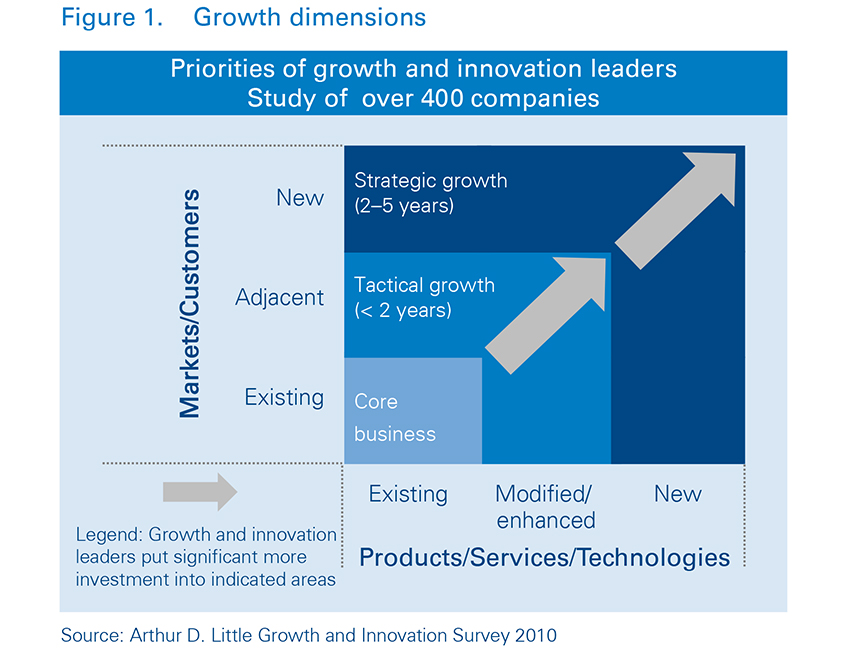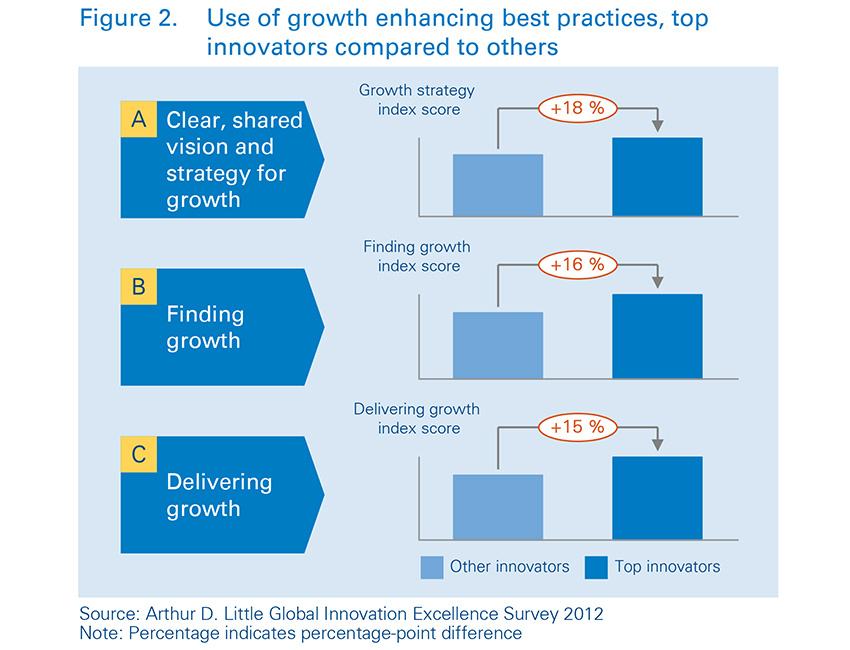By: Anders Johannson / Björn Nilsson / Daniel Roos / Karin Gyllin
Growth is on the top of the management agenda as shareholders simply demand return on invested capital and current business is not delivering it. So what is the best route companies can take to achieve it? How can companies create and accelerate growth? To succeed companies must possess the capabilities and take a systematic approach to go beyond their core business.

Looking beyond your core business
A recent ADL survey shows that the importance of growth outside the core business will increase. Companies estimate that as much as 42% will come from new areas of growth in 2020 compared to 20% in 2010. This will push companies to look to both adjacent and new areas to reach their growth targets.
FIGURE 1.
According to Arthur D. Little‘s Global Innovation Excellence Survey 2012, top innovators obtain a higher share of their revenues from products/services launched within the last three years and also benefit from shorter time to break even. The top quartile innovators show an average of 13% higher profit from new products/services and an average of 30% shorter time to break even compared to others. However, the gap has narrowed compared to previous years, displaying that it is becoming increasingly difficult to stay ahead of competition. The question therefor arises “what are the prerequisites for a company to achieve successful and sustainable growth?”
To succeed companies need to excel in every step of the growth journey, from creating a clear and shared vision for growth, to finding and delivering the growth. Arthur D. Little’s Innovation Excellence survey 2012 shows that top innovators use growth enhancing best practices for each of these three steps 15-18% more than others.
FIGURE 2.
Our survey also shows that top innovators have overcome many of the common challenges in innovation based growth such as obtaining management support, creating alignment towards a common growth strategy, establishing cross-functional relationships and enabling fast decision making.
Arthur D. Little’s framework for successful innovation-based growth
Arthur D. Little’s Growth Accelerator Program brings together the Why, the What and the How of innovation-based growth. It helps companies answer the two fundamental questions of growth: Where do we find growth opportunities and how do we deliver on the growth strategy?
The Growth Accelerator Modules spans across three layers of business creation(FIGURE 3):
FIGURE 3.
A. Creating a clear, shared vision and strategy for growth
A clear and shared vision is a prerequisite to succeed in finding and delivering growth. It serves as a compass, providing direction on the growth journey. What are your core competencies? What is a good strategic fit for your company? Without it you risk spending lots of resources, time and money on a large portfolio of growth initiatives and lose focus on the ones that truly can make a difference for your company.
B. Finding growth
Opportunities for growth can be found by understanding the fundamental forces of change in your markets and technologies and by linking unmet needs to innovative solutions.
- Customers and markets. Can you intensify your sales in current markets? Are there unmet needs or customer groups that you are not serving properly? Which megatrends and major value chain changes will impact your end markets and what is the best way to respond?
- Competencies and technologies. What are your core competencies and how can you leverage them in adjacent fields? What new features, products and systems solutions can you develop building on your unique competencies? Which emerging technologies may have a disruptive impact on your businesses in the future?
- Opportunity spaces. Future unmet needs and solutions are brought together in a module called Opportunity spaces. The potential of the opportunities spaces are evaluated against their strategic fit to the company’s vision and competencies. One way in which opportunity spaces for strategic growth initiatives can be systematically explored is by using a Checkerboard. (FIGURE 4).
FIGURE 4.
Our “checkerboarding” approach helps managers to analyze the opportunities spaces in a systematic and pragmatic way. The approach points to distinct opportunity spaces, i.e. potential new growth areas. These areas are defined as the intersection between megatrends or emerging technology fields on the one hand and end markets on the other.
Case example
A high-end steel service provider active in the European market developed a growth strategy to assess the feasibility of entering the renewable energy market. By evaluating their capabilities and matching them to the most attractive opportunities in four different growth areas six validated opportunities were identified, which could realistically lead to >20% additional revenue. In addition concrete business leads were identified.
C. Delivering growth
Delivering growth requires a clear roadmap of where to go combined with an implementation that considers both what the company needs to deliver as well as how to get there:
- Growth roadmaps. For selected opportunities we create actionable Growth roadmaps covering different growth horizons:
- Intensification: ways to protect and increase your company‘s turnover of existing products and services within the existing customer base (“defend and grow the core”).
- Enhancement: ways to broaden your customer base through smart new combinations of existing technologies and markets (“extend the core”).
- Enlargement: ways to enlarge your product and service portfolio or develop new applications (“grow beyond the core”).
- Pilots and roll-out. We strongly believe in the value of continuous learning, testing and adjusting. That is why in previous client engagements we have set up pilot projects to deliver early wins and ensure that the Growth Accelerator becomes your company’s way of working.
FIGURE 5.
- Organization and processes. Knowing where and how to grow is one thing, embedding it in the organization is quite another. Does an opportunity fit comfortably in an existing Business Unit or should it first mature someplace else? Is it wise to do it alone or should you work with partners?
- Culture and change. Fundamentally, the Growth Accelerator is about helping teams and individuals see the right way forward and understand it is not a one-off event but a continuous journey. Culture and change management therefore must be an explicit part of the program from day one.
- Capabilities and tools. Realizing the growth potential in new areas requires new capabilities – e.g. in business development or in customer intelligence. We will identify those needs and help you solve them, be it through tool development, setting up competence development centers or by learning from other (non-competing) companies.
Case example
A leading packaging company used the Growth Accelerator Framework to build group-wide strategic marketing capabilities to enable the organization to realize growth opportunities and achieve growth excellence. To do so they developed a Growth Accelerator Toolbox with 12 modules (i.e. market segmentation, technology scan, value proposition, product roadmap, business plan, go-to-market strategy) to build capabilities. They then successfully implemented the toolbox using training programs and a roll-out program including pilots to ensure a sustainable change.
Insights for the executive
Growth is more than ever essential for companies’ success and survival. Our Innovation Excellence survey shows that innovation is a main driver for growth where the top quartile innovators obtain on average 13% more profit from new products and services than others, and 30% shorter time to break-even. Our survey also indicates that companies with higher innovation success use growth enhancing best practices some 15-18% more than others.
Arthur D. Little’s Growth Accelerator Framework offers a holistic and structured approach to answer the critical questions for successful innovation-based growth. Our approach is not just effective, it is also unique in that it brings together the key modules of innovation-based growth; it joins the traditional ‘market pull’ and ‘technology push’; it builds multifunctional teams, typically from Marketing, R&D, Supply Chain and Operations; and it builds new capabilities and initiates change and fosters entrepreneurship in your company.
Companies looking to enhance growth should start by determining objectively and specifically the shape that they are in today in terms of ‘growth readiness’:
- Do we have a clear and shared vision and strategy for growth in new business areas?
- Do we use a systematic process to identify hidden needs, impact of trends, new use of technologies and capabilities and frameworks to visualize opportunities and create roadmaps?
- Are we able to develop and market a compelling value proposition for innovations with a dedicated function and supporting processes that allows fast to market roll-out programs?
- And do we have the ability and willingness to overcome the internal barriers to growth that are holding back so many others?
By : Anders Johansson, Daniel Roos, Björn Nilsson & Karin Gyllin
About the authors
 Anders Johansson is a Partner at Arthur D. Little’s Gothenburg office and leads the Global Technology Innovation Management Practice.
Anders Johansson is a Partner at Arthur D. Little’s Gothenburg office and leads the Global Technology Innovation Management Practice.
 Daniel Roos is a Principal at Arthur D. Little’s Gothenburg office and leads the Nordic Technology Innovation Management Practice.
Daniel Roos is a Principal at Arthur D. Little’s Gothenburg office and leads the Nordic Technology Innovation Management Practice.
 Björn Nilsson is a consultant at Arthur D. Little’s Gothenburg office and a member of the Technology Innovation Management Practice.
Björn Nilsson is a consultant at Arthur D. Little’s Gothenburg office and a member of the Technology Innovation Management Practice.
 Karin Gyllin is a consultant at Arthur D. Little’s Stockholm office and a member of the Technology Innovation Management Practice.
Karin Gyllin is a consultant at Arthur D. Little’s Stockholm office and a member of the Technology Innovation Management Practice.
Photo : Concept of Growing company by Shutterstock.com






